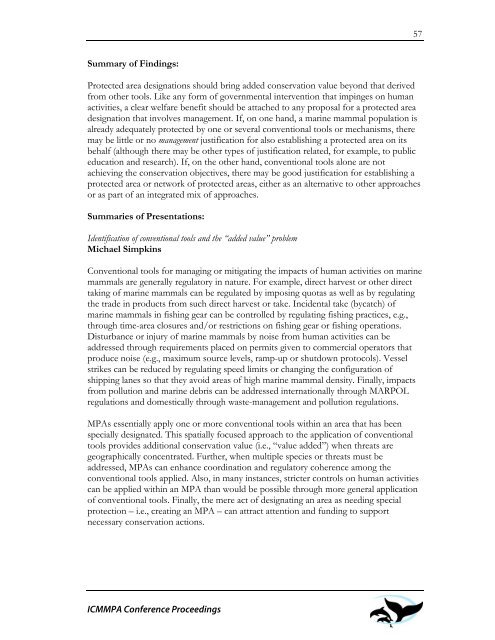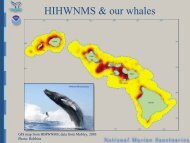The First International Conference on Marine Mammal Protected Areas
The First International Conference on Marine Mammal Protected Areas
The First International Conference on Marine Mammal Protected Areas
Create successful ePaper yourself
Turn your PDF publications into a flip-book with our unique Google optimized e-Paper software.
Summary of Findings:<br />
<strong>Protected</strong> area designati<strong>on</strong>s should bring added c<strong>on</strong>servati<strong>on</strong> value bey<strong>on</strong>d that derived<br />
from other tools. Like any form of governmental interventi<strong>on</strong> that impinges <strong>on</strong> human<br />
activities, a clear welfare benefit should be attached to any proposal for a protected area<br />
designati<strong>on</strong> that involves management. If, <strong>on</strong> <strong>on</strong>e hand, a marine mammal populati<strong>on</strong> is<br />
already adequately protected by <strong>on</strong>e or several c<strong>on</strong>venti<strong>on</strong>al tools or mechanisms, there<br />
may be little or no management justificati<strong>on</strong> for also establishing a protected area <strong>on</strong> its<br />
behalf (although there may be other types of justificati<strong>on</strong> related, for example, to public<br />
educati<strong>on</strong> and research). If, <strong>on</strong> the other hand, c<strong>on</strong>venti<strong>on</strong>al tools al<strong>on</strong>e are not<br />
achieving the c<strong>on</strong>servati<strong>on</strong> objectives, there may be good justificati<strong>on</strong> for establishing a<br />
protected area or network of protected areas, either as an alternative to other approaches<br />
or as part of an integrated mix of approaches.<br />
Summaries of Presentati<strong>on</strong>s:<br />
Identificati<strong>on</strong> of c<strong>on</strong>venti<strong>on</strong>al tools and the “added value” problem<br />
Michael Simpkins<br />
C<strong>on</strong>venti<strong>on</strong>al tools for managing or mitigating the impacts of human activities <strong>on</strong> marine<br />
mammals are generally regulatory in nature. For example, direct harvest or other direct<br />
taking of marine mammals can be regulated by imposing quotas as well as by regulating<br />
the trade in products from such direct harvest or take. Incidental take (bycatch) of<br />
marine mammals in fishing gear can be c<strong>on</strong>trolled by regulating fishing practices, e.g.,<br />
through time-area closures and/or restricti<strong>on</strong>s <strong>on</strong> fishing gear or fishing operati<strong>on</strong>s.<br />
Disturbance or injury of marine mammals by noise from human activities can be<br />
addressed through requirements placed <strong>on</strong> permits given to commercial operators that<br />
produce noise (e.g., maximum source levels, ramp-up or shutdown protocols). Vessel<br />
strikes can be reduced by regulating speed limits or changing the c<strong>on</strong>figurati<strong>on</strong> of<br />
shipping lanes so that they avoid areas of high marine mammal density. Finally, impacts<br />
from polluti<strong>on</strong> and marine debris can be addressed internati<strong>on</strong>ally through MARPOL<br />
regulati<strong>on</strong>s and domestically through waste-management and polluti<strong>on</strong> regulati<strong>on</strong>s.<br />
MPAs essentially apply <strong>on</strong>e or more c<strong>on</strong>venti<strong>on</strong>al tools within an area that has been<br />
specially designated. This spatially focused approach to the applicati<strong>on</strong> of c<strong>on</strong>venti<strong>on</strong>al<br />
tools provides additi<strong>on</strong>al c<strong>on</strong>servati<strong>on</strong> value (i.e., “value added”) when threats are<br />
geographically c<strong>on</strong>centrated. Further, when multiple species or threats must be<br />
addressed, MPAs can enhance coordinati<strong>on</strong> and regulatory coherence am<strong>on</strong>g the<br />
c<strong>on</strong>venti<strong>on</strong>al tools applied. Also, in many instances, stricter c<strong>on</strong>trols <strong>on</strong> human activities<br />
can be applied within an MPA than would be possible through more general applicati<strong>on</strong><br />
of c<strong>on</strong>venti<strong>on</strong>al tools. Finally, the mere act of designating an area as needing special<br />
protecti<strong>on</strong> – i.e., creating an MPA – can attract attenti<strong>on</strong> and funding to support<br />
necessary c<strong>on</strong>servati<strong>on</strong> acti<strong>on</strong>s.<br />
ICMMPA <str<strong>on</strong>g>C<strong>on</strong>ference</str<strong>on</strong>g> Proceedings<br />
57



